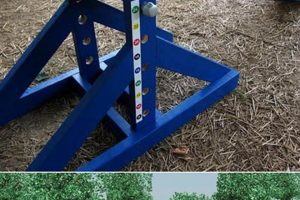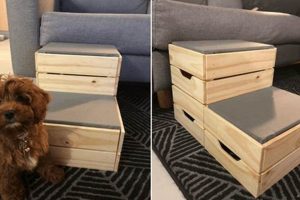Constructing an inclined plane to assist canines in navigating elevated surfaces, typically steps, is a growing trend among pet owners. This structure facilitates easier access for dogs that may have mobility issues due to age, injury, breed predisposition, or other health concerns. The purpose-built apparatus provides a gentler slope compared to standard staircases, reducing strain on joints and muscles. For example, a small breed dog or one with arthritis might benefit significantly from such an aid.
The advantages of creating a supportive pathway for canine companions are multifaceted. A primary benefit is the promotion of joint health, potentially mitigating pain and slowing the progression of conditions such as arthritis. Furthermore, it can increase a dog’s independence and quality of life, allowing them to move freely throughout the home without assistance. Historically, improvised solutions, like blankets or cushions, were used before dedicated structures gained popularity. However, these options often lacked stability and proper incline, making them less effective and potentially unsafe.
Therefore, the following will address key aspects involved in creating such a support structure. We will cover material selection, design considerations, construction techniques, and safety precautions, ultimately providing a guide to ensure a safe and effective result.
Essential Considerations for Canine Step Assistance
The following recommendations address critical points to consider when planning and executing the construction of an inclined plane for canine use. Emphasis is placed on safety, durability, and the specific needs of the animal.
Tip 1: Measure Accurately. The height of the stairs and the available floor space are crucial for determining the ramp’s length and angle. Insufficient length will result in too steep of an incline, negating the intended benefit. A gentle slope is paramount.
Tip 2: Select Appropriate Materials. Use durable, non-toxic materials suitable for indoor or outdoor use, as needed. Pressure-treated lumber may be necessary for exterior applications. Avoid materials with splinters or sharp edges that could injure the animal.
Tip 3: Ensure Adequate Traction. The walking surface must provide sufficient grip to prevent slipping, especially for elderly or disabled dogs. Carpet remnants, rubber mats, or textured paint can enhance traction.
Tip 4: Prioritize Structural Integrity. The ramp must be robust enough to support the dog’s weight without wobbling or collapsing. Reinforce joints and connections to withstand repeated use.
Tip 5: Consider the Dog’s Size and Breed. Larger dogs require wider and more structurally sound ramps. Breeds prone to certain health issues may need a shallower incline or additional features like side rails.
Tip 6: Incorporate Safety Rails (Optional). Low rails or side panels can help prevent falls, particularly for dogs with impaired vision or balance problems. These are especially useful for higher ramps.
Tip 7: Gradual Introduction. After construction, introduce the new structure to the dog slowly and positively, using treats and encouragement. Avoid forcing the dog to use it initially.
Careful planning and construction, adhering to these tips, will ensure a safe, effective, and long-lasting solution for assisting canines with mobility challenges.
The next section will elaborate on detailed construction methodologies, addressing specific challenges and offering practical solutions.
1. Slope Angle
The degree of inclination, termed the slope angle, is a paramount consideration in the design and construction of a supportive structure for canines navigating steps. Its impact extends beyond mere convenience, influencing the animal’s physical well-being and the overall utility of the apparatus.
- Joint Strain Minimization
A shallow slope angle reduces stress on canine joints, particularly the hips, knees, and back. Excessive steepness exacerbates existing conditions such as arthritis or hip dysplasia. A gentler incline, while requiring more horizontal space, distributes the dog’s weight more evenly, minimizing discomfort and potential injury. Consider, for instance, a ramp designed for a Dachshund, a breed predisposed to back problems, which would necessitate an exceptionally gradual slope.
- Usability Across Canine Demographics
The optimal slope angle varies depending on the dog’s size, breed, age, and physical condition. A ramp designed for a large, agile breed might have a steeper angle than one intended for a small, elderly dog. Failing to account for these differences can render the structure unusable or even dangerous. For example, a steep ramp might be manageable for a young Labrador but impossible for a senior Chihuahua.
- Space Constraints and Angle Optimization
Practical limitations often dictate the maximum length of the ramp, thereby influencing the achievable slope angle. Smaller living spaces necessitate steeper inclines, requiring a trade-off between space efficiency and joint strain. Strategic design, such as incorporating folding mechanisms or utilizing otherwise unused spaces (e.g., under a staircase), can mitigate this challenge. Consider the difference between a sprawling suburban home and a compact urban apartment in determining optimal ramp length and angle.
- Safety and Grip Considerations
A steeper slope angle increases the risk of slipping, even with adequate surface traction. The combination of a high incline and insufficient grip can lead to falls and injuries. Countermeasures include selecting high-traction materials (e.g., textured rubber) and incorporating horizontal slats or steps at regular intervals to provide added purchase. Visualize a smooth, steeply angled ramp in comparison to one with a more gradual slope and enhanced gripthe safety differential is significant.
In conclusion, the slope angle is not merely a geometric parameter but a critical determinant of the effectiveness and safety. Accurate assessment of the canine’s specific needs, combined with careful consideration of space constraints and material properties, is essential for creating an appropriate and beneficial canine step assistance.
2. Surface Traction
Surface traction is a critical element in the construction of any canine inclined plane for stairs. It directly impacts the safety and usability of the structure, influencing the dog’s confidence and willingness to use it, while reducing the risk of slips and falls.
- Material Selection and Traction Coefficient
The choice of surface material dictates the level of grip available. Materials with a high coefficient of friction, such as textured rubber or low-pile carpet, provide superior traction compared to smooth surfaces like polished wood or tile. The selection process should consider the dog’s breed, age, and any existing mobility issues. For example, a ramp intended for a senior dog with arthritis requires a surface with significantly higher traction than one for a young, agile dog.
- Textural Enhancement Techniques
Beyond material selection, several techniques can enhance surface traction. Grooves or ridges can be incorporated into the surface to provide additional grip. The application of non-slip coatings, such as textured paint or epoxy, is another option. Consider, for instance, adding horizontal wooden slats to the surface; this provides both visual cues and increased grip, improving stability for the animal.
- Environmental Considerations and Traction Maintenance
External factors, such as moisture, can significantly reduce surface traction. Indoor ramps are less susceptible to this issue than outdoor ramps, which may become slippery due to rain, snow, or ice. Regular cleaning and maintenance are essential to remove debris and prevent the buildup of substances that could compromise traction. In colder climates, de-icing measures may be necessary to ensure safe usage.
- Impact of Slope Angle on Traction Requirements
The steeper the ramp’s incline, the greater the demand for effective surface traction. A shallow slope allows for a wider range of acceptable materials, while a steeper slope necessitates a more aggressive traction solution. The relationship between slope angle and surface traction should be carefully balanced to minimize the risk of slippage. For a high-incline ramp, a combination of high-friction materials and textural enhancements may be required to achieve adequate safety.
In summary, appropriate surface traction is not merely an aesthetic consideration but a fundamental safety feature for dog step assistance. Careful attention to material selection, texture enhancement, environmental factors, and the relationship between slope angle and traction requirements is essential for creating a safe and effective structure.
3. Weight Capacity
The weight capacity of a homemade inclined structure designed for canine stair assistance constitutes a critical safety parameter directly influencing its structural integrity and the well-being of the animal. This parameter dictates the maximum load the structure can bear without risk of failure, encompassing both static weight (the dog’s weight at rest) and dynamic forces (the impact generated during ascent and descent). The intended user’s size and breed fundamentally determine the required weight-bearing capability. A small breed, such as a Chihuahua, will impose significantly less stress on the ramp compared to a large breed, such as a Great Dane. Underestimating the weight capacity can result in structural collapse, potentially causing serious injury to the animal. For example, a ramp constructed from thin plywood and designed for a small dog may catastrophically fail under the weight of a larger breed, leading to a fall.
Accurate assessment of the dog’s weight, coupled with a safety factor to account for dynamic forces and material degradation over time, is essential. Engineering principles dictate that the ramp’s support structure, including the frame, supports, and surface material, must be capable of withstanding the calculated load with a comfortable margin of safety. Material selection plays a pivotal role; stronger materials, such as hardwood or reinforced plywood, offer greater weight-bearing capacity compared to softer woods. Furthermore, the design of the support structure, including the spacing and size of the supports, directly impacts the ramp’s ability to distribute weight evenly. A well-designed support system can significantly enhance the overall strength and stability of the structure, mitigating the risk of localized stress concentrations that could lead to failure. The fasteners used to join the various components must also be appropriately sized and rated to withstand the anticipated forces.
In conclusion, weight capacity is not merely a numerical specification but a fundamental design constraint that directly affects the safety and longevity of a home-built canine stair assistance. A failure to adequately address this parameter can have severe consequences, underscoring the importance of meticulous planning, careful material selection, and adherence to sound engineering principles. Ongoing monitoring and periodic inspection of the structure are also advisable to identify and address any signs of wear or weakening that could compromise its load-bearing capability.
4. Material Durability
The longevity and safety of a canine inclined plane for stairs are intrinsically linked to the durability of the materials employed in its construction. Material selection directly impacts the structure’s ability to withstand repeated use, environmental stressors, and the weight of the animal, ultimately determining its useful lifespan and minimizing the risk of failure.
- Resistance to Environmental Degradation
Outdoor structures are subjected to weathering, including rain, sunlight, and temperature fluctuations. Materials susceptible to rot, corrosion, or UV damage will degrade rapidly, compromising the ramp’s structural integrity. Pressure-treated lumber, weather-resistant coatings, and rust-proof fasteners are essential for outdoor applications to mitigate these effects. Neglecting this aspect could result in a weakened structure prone to collapse.
- Withstanding Physical Stress and Abrasion
The walking surface of the ramp experiences constant abrasion from the dog’s claws. Materials with low abrasion resistance will wear down quickly, creating a slippery or uneven surface. Durable materials such as hardwood, rubber, or carpet remnants can withstand this wear and tear, maintaining a safe and functional walking surface over time. Consider the difference between a ramp surfaced with thin fabric versus one with a durable, ribbed rubber mat.
- Load-Bearing Capacity and Structural Integrity
The frame and support structure of the ramp must be constructed from materials capable of bearing the dog’s weight without bending, cracking, or breaking. Under-dimensioned or low-strength materials can lead to structural failure, particularly under dynamic loading (e.g., when the dog is running up the ramp). Selecting materials with adequate load-bearing capacity is crucial for ensuring the ramp’s safety and stability. A frame constructed of softwood, for instance, may not be suitable for a large breed dog.
- Resistance to Biological Degradation
Materials used in the ramp’s construction should be resistant to pests such as insects and rodents that can compromise the structural integrity of the ramp. This is particularly important for structures built outdoors. Certain types of wood are naturally resistant to insect infestation, while others may require treatment with preservatives. Failure to protect the ramp from biological degradation can lead to rapid deterioration and eventual collapse. Untreated wood left in contact with the ground is particularly vulnerable.
Therefore, material durability is not merely a cosmetic consideration; it is a fundamental factor determining the safety, longevity, and overall value of a canine step assistance device. Selecting materials appropriate for the intended environment and usage conditions is essential for ensuring a safe and reliable structure for the animal.
5. Width Adequacy
Width adequacy, in the context of structures designed to aid canines in navigating stairs, constitutes a crucial dimension impacting usability and safety. The transverse dimension of a stair-assistive ramp directly influences the dog’s ability to ascend or descend comfortably and confidently. Insufficient width can lead to hesitancy, missteps, and an increased risk of falls, negating the intended benefit of the structure. For instance, a narrow ramp might force a larger breed dog to walk with an unnatural gait, increasing joint strain and potentially causing injury. Conversely, adequate width allows for a more natural and stable movement, promoting both physical safety and psychological comfort.
Several factors influence the determination of appropriate width. Breed size is a primary consideration; larger breeds necessitate wider ramps to accommodate their broader stance. Individual gait and stride length also play a role; some dogs have a wider or more erratic gait, requiring additional lateral space. Furthermore, the presence of side rails or boundaries impacts the usable width; interior dimensions between rails must still accommodate the dog’s body. Consider, for example, a Golden Retriever, a breed known for its broad chest and relatively long stride. A ramp designed for this breed must have sufficient width to prevent the dog from feeling cramped or unstable during use. Similarly, a shorter-legged dog might require less width, though stability is still paramount.
In conclusion, the transverse dimension of a ramp, or the degree of its width adequacy, is not an arbitrary measurement but a critical design element. Careful consideration of breed size, individual gait, and the presence of side rails is essential to ensure the structure provides safe and effective assistance. A ramp that is too narrow can be as detrimental as no ramp at all, underscoring the importance of prioritizing this dimension during the design and construction phases. Furthermore, a well-designed ramp must maintain sufficient width along its entire length, avoiding any constrictions that could impede the dog’s movement.
6. Secure Fastening
The reliability of a canine stair assistance device is inextricably linked to the integrity of its fastening mechanisms. Secure fastening, in the context of a home-built ramp, represents the method by which individual components are joined to create a unified, load-bearing structure. Inadequate fastening techniques directly compromise the ramp’s ability to withstand the forces exerted during canine use, leading to potential instability and structural failure. The cause-and-effect relationship is direct: weak joints result in a weakened structure, increasing the risk of collapse. For instance, using insufficient screws or nails to attach the ramp’s surface to its frame may result in the surface detaching under the dog’s weight, creating a tripping hazard.
The importance of secure fastening is amplified by the dynamic forces involved. Dogs do not simply walk statically; their movements involve impact and shifting weight, placing considerable stress on the ramp’s joints. Proper fastening techniques must account for these dynamic loads. This includes selecting appropriate fasteners (e.g., screws, bolts, construction adhesive) based on the materials being joined and the anticipated stress levels. Consider the difference between using simple wood screws versus lag bolts to secure the frame of a ramp designed for a large-breed dog; the latter provides significantly greater holding power and resistance to shear forces. Furthermore, proper execution is critical. Screws must be driven straight and to the correct depth, while bolts must be tightened adequately to ensure a secure connection.
In conclusion, secure fastening is a non-negotiable element in the construction of a safe and effective home-built canine stair assistance device. Its absence directly undermines the structure’s integrity, increasing the risk of injury to the animal. Understanding the principles of load transfer, selecting appropriate fasteners, and employing proper installation techniques are essential for ensuring a robust and reliable ramp. Regular inspection and maintenance of the fastening mechanisms are also advisable to identify and address any signs of loosening or deterioration over time, further safeguarding the animal’s well-being.
Frequently Asked Questions
The following addresses common inquiries regarding the design, construction, and implementation of canine step assistance structures, intended to provide clarity and guidance for prospective constructors.
Question 1: What is the generally accepted slope angle for an inclined plane intended for canine use?
The optimal slope angle varies depending on the canine’s size, age, and physical condition. However, a range between 18 and 26 degrees is generally considered suitable for many dogs. Steeper angles may present challenges for smaller or mobility-impaired animals.
Question 2: Which materials are most appropriate for constructing a durable and weather-resistant outdoor ramp?
Pressure-treated lumber is often recommended for its resistance to rot and insect infestation. Alternatively, composite decking materials offer durability and low maintenance. Stainless steel fasteners are crucial to prevent corrosion.
Question 3: How can sufficient traction be assured on a ramp surface, particularly in wet conditions?
Textured rubber surfaces, outdoor carpeting, or the application of non-slip coatings are effective methods for enhancing traction. Regularly cleaning the surface to remove debris is also essential.
Question 4: What is the recommended width for a ramp intended for a large-breed dog, such as a Labrador Retriever?
A minimum width of 18 inches is generally recommended for large-breed dogs to allow for comfortable and stable movement. Wider ramps may be necessary for exceptionally broad-chested individuals.
Question 5: How can the stability and weight-bearing capacity of a homemade ramp be maximized?
Employing a robust frame constructed from solid wood and ensuring adequate support structures are critical. Using appropriately sized fasteners and construction adhesive at all joints will further enhance stability.
Question 6: What safety precautions should be considered when introducing a canine to a newly constructed ramp?
A gradual introduction with positive reinforcement is recommended. Initially, guide the dog up and down the ramp using treats and praise. Avoid forcing the dog, and ensure the ramp is securely positioned to prevent slippage.
Careful consideration of these questions and their corresponding answers contributes to the creation of a safe and effective canine step assistance structure, promoting the animal’s well-being and independence.
The subsequent discussion will address specialized design considerations for canines with unique needs or physical limitations.
Conclusion
The foregoing has detailed essential considerations for the design and construction of a “diy dog ramp for stairs.” Proper planning and execution are paramount to ensure a safe and effective structure. Crucial factors include appropriate slope angle, adequate surface traction, robust weight capacity, material durability, sufficient width, and secure fastening. The omission of any element may lead to injury or structural failure, defeating the apparatus’s intended purpose.
The creation of a safe “diy dog ramp for stairs” requires diligence and adherence to sound engineering principles. Prioritizing the canine’s well-being is central to responsible pet ownership. The construction of a structurally sound and thoughtfully designed ramp is not merely a convenience but a commitment to the animal’s health and quality of life, particularly in the face of age-related or breed-specific mobility challenges. Constructing a “diy dog ramp for stairs” requires diligent and careful adherence to established safety criteria. The ultimate goal is the enhanced mobility and improved life quality of the canine companion.







